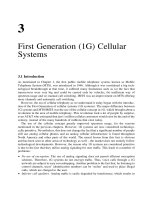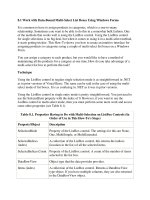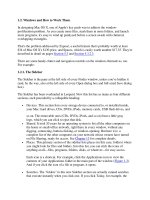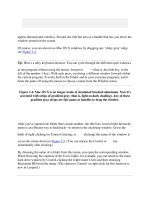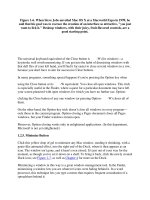first responders when your systems have to work
Bạn đang xem bản rút gọn của tài liệu. Xem và tải ngay bản đầy đủ của tài liệu tại đây (4.32 MB, 27 trang )
VELOCITY 2013 • SANTA CLARA | NEW YORK | BEIJING | LONDON
Building a Faster
and Stronger Web
Velocity is much more than a
conference; it’s become the
essential training event for web
operations and development
professionals from companies
of all sizes.
Conference tracks:
n Web Performance
n Operations
n Mobile Performance
n Velocity Culture
June 18-20, 2013
Santa Clara, CA
Register now to reserve your seat
velocityconf.com/sc
Save
20%
e
with cod
VEL20
Stay current on the latest Velocity news and updates
velocityconf.com
©2013 O’Reilly Media, Inc. The O’Reilly logo is a registered trademark of O’Reilly Media, Inc. 13117b
Learning from First
Responders: When Your
Systems Have to Work
Dylan Richard
Learning from First Responders: When Your Systems Have to Work
by Dylan Richard
Copyright © 2013 O’Reilly Media. All rights reserved.
Printed in the United States of America.
Published by O’Reilly Media, Inc., 1005 Gravenstein Highway North, Sebastopol, CA
95472.
O’Reilly books may be purchased for educational, business, or sales promotional use.
Online editions are also available for most titles (). For
more information, contact our corporate/institutional sales department: (800)
998-9938 or
February 2013:
First Edition
Revision History for the First Edition:
2013-03-04:
First release
See for release details.
Nutshell Handbook, the Nutshell Handbook logo, and the O’Reilly logo are registered
trademarks of O’Reilly Media, Inc.
Many of the designations used by manufacturers and sellers to distinguish their prod‐
ucts are claimed as trademarks. Where those designations appear in this book, and
O’Reilly Media, Inc. was aware of a trademark claim, the designations have been printed
in caps or initial caps.
While every precaution has been taken in the preparation of this book, the publisher
and authors assume no responsibility for errors or omissions, or for damages resulting
from the use of the information contained herein.
ISBN: 978-1-449-36414-4
Table of Contents
1. Introduction. . . . . . . . . . . . . . . . . . . . . . . . . . . . . . . . . . . . . . . . . . . . . . . . 1
2. 18 Months to Build Software that Absolutely Has to Work for 4 Days 3
3. Planning. . . . . . . . . . . . . . . . . . . . . . . . . . . . . . . . . . . . . . . . . . . . . . . . . . . 7
4. Starting the Exercise. . . . . . . . . . . . . . . . . . . . . . . . . . . . . . . . . . . . . . . . 11
5. Real Breaking. . . . . . . . . . . . . . . . . . . . . . . . . . . . . . . . . . . . . . . . . . . . . . 15
6. Reflections. . . . . . . . . . . . . . . . . . . . . . . . . . . . . . . . . . . . . . . . . . . . . . . . 17
iii
CHAPTER 1
Introduction
In early summer of 2011 a group of technologists was assembled to
build infrastructure and applications to help reelect The President of
the United States of America. At the onset, the technology team at
Obama for America (OFA) had just shy of 18 months to bring together
a team of 40 odd technologists, define the technical direction, build
out the infrastructure, and develop and deploy hundreds of applica‐
tions. These applications all needed to be in place as soon as possible
and would be vital to helping the campaign organize in some way.
With that in mind we pulled together a team of amazing engineers
(most with non-political backgrounds) and started the process of
building on top of what the previous presidential cycle had started. In
large part the main task was to refactor an existing infrastructure in
order to unify several disparate vendor applications into a well-defined
and consistent application programming interface (API) that could
enable brand new applications. These were as disparate as new vendor
integrations to the tools that would help our more than 750,000 vol‐
unteers organize, fundraise, and talk directly to voters (along with
hundreds of other backend and user-facing applications) to be built
on top of it. In addition to building the core API, we also had to actually
build the aforementioned applications, most of which were expected
to scale to sustained traffic on the order of thousands of requests per
second. All this while an organization the size of a fortune 500 com‐
pany is being built up around you and needs to use those applications
to help it grow.
No big deal.
1
All of this needed to be functional as soon as possible because at the
scale of volunteering we were talking about, transitioning people to a
new tool too late in the game was not a realistic option, no matter how
clean it was coded or how nicely designed. And so, working with our
product management team and the rest of the campaign we spent the
lion’s share of the next year and a half building out the basic infra‐
structure and all features that would allow organizers and other staff
to benefit from these applications.
As election day neared, it became clear that the focus the team had
maintained for the “building” phase of the campaign needed to
change. Performance and features had been the guiding principles up
to this point; stability had been an important, but secondary goal. But
for us to truly succeed on the four days that mattered most, we had to
focus our efforts on making our applications and core infrastructure
rock-solid in ways that the team had not fathomed before.
2
|
Chapter 1: Introduction
CHAPTER 2
18 Months to Build Software that
Absolutely Has to Work for 4 Days
With the team’s focus so much on producing the software, adding fea‐
tures, and engineering for scale, a culture and way of working formed
organically that was generally functioning, but had a couple of major
flaws. We were finding ourselves shipping certain products (like the
core of our API) and ignoring others (like the underpinnings for what
would become our targeted Facebook sharing). This was happening
without a grander view of what was important and without a focus on
things that we as engineers found compelling, sacrificing other im‐
portant products that needed to be built. In an effort to address these
flaws while maintaining the agility and overall productivity, small
teams were formed that focused on single workstreams.
As they were asked to do, these teams put their focus on servicing the
needs of their workstream and only their workstream. Dividing the
labor in this way ensured that we were not sacrificing functionality
that would be incredibly important to one department in order to go
deeper on other functionality for another department. In other words,
it allowed us to service more widely rather than incredibly deeply.
The unfortunate flip side of this division of labor was an attitudinal
shift away from everyone working together toward a single goal and
toward servicing each workstream in a vacuum. This shift manifested
itself in increased pain and frustration in integration, decreased intrateam communication, and increased team fracturing. Having that lev‐
el of fracturing when we were metaphorically attempting to rebuild an
airplane mid-flight was an incredible cause for concern. This fractur‐
3
ing grew over time, and after about a year it got to the point that it
forced us to question the decision of dividing and conquering and left
us searching for ways to help the various teams work together more
smoothly.
A fortuitous dinner with Harper Reed (the Chief Technology Officer
at OFA) and a friend (Marc Hedlund) led to a discussion about the
unique problems a campaign faces (most startups aren’t dealing with
arcane election laws) and the more common issues that you’d find in
any engineering team.
While discussing team fracturing, insanely long hours, and focusing
on the right thing, Marc suggested organizing a “game day” as a way
to bring the team together. It would give the individual teams a wellneeded shared focus and also allow everyone to have a bit of fun.
This plan struck an immediate chord. When Harper and I had worked
at Threadless, large sales were planned each quarter. The time between
each sale was spent refactoring and adding new features. A sale would
give the team a laser focus on the things that were the most important,
in this order: keep the servers up, take money, and let people find
things to buy. Having that hard deadline with a defined desired out‐
come always helped the engineers put their specific tasks in context of
the greater goal and also helped the business stakeholders prioritize
functionality and define their core needs.
It also dovetailed nicely with the impending election. We were about
two months out from the ultimate test of the functionality and infra‐
structure we had been building for all of these months. Over that time
we had some scares. A couple of unplanned incidents showed us some
of the limitations of our systems. The engineers had been diligent at
addressing these failures by incorporating the failures into our unit
tests and making small architectural changes to eliminate these points
of failure. However, we knew that we had only seen the tip of the ice‐
berg in terms of the kinds of scale and punishment our systems and
applications would encounter.
4
|
Chapter 2: 18 Months to Build Software that Absolutely Has to Work for 4 Days
We knew that we needed to be better prepared — both to know what
could fail but also what that failure looks like, what to do in case of
failure, and to make sure that we as a team could deal with that failure.
If we could do this game day right, we could touch and improve on a
bunch of these issues and at the very least have a ton of fun doing it.
With that in mind, we set out to do the game day as soon as possible.
By this point we were about six weeks before election day.
18 Months to Build Software that Absolutely Has to Work for 4 Days
|
5
CHAPTER 3
Planning
Moving election day back a bit to accommodate this plan was a nonstarter, as you might imagine. A concerted and hasty effort had to be
organized to pull off a game day only a month prior to the election.
The management team dedicated time to trading horses and smooth‐
ing feathers to buy the engineering team time to be able to prepare for
failure.
The eventual compromise that was reached for buying that prepara‐
tion time was finishing up another couple of weeks of features followed
by a considerable (for the campaign) two-week feature freeze to code
around failure states. This was done both to keep the engineers on
their toes as well as keep the teams from shifting their focus too early.
Engineers weren’t told about the game day until about two weeks be‐
fore it would take place — in other words, not until the feature freeze
time were the teams spending their effort on preparation.
The teams were informed on October 2nd that game day would take
place on the 19th of October. The teams had 17 days to failure-proof
the software they had been building for 16 months. There was abso‐
lutely no way the teams could failure proof everything, and that was a
good thing. If it wasn’t absolutely important for our “Get Out The Vote”
efforts, the application should fail back to a simple read-only version
or repoint the DNS to the homepage and call it a day. Because of this
hard deadline, the teams did not waste time solving problems that
didn’t matter to the core functionality of their applications.
Lead engineers, management, and project managers met with stake‐
holders and put together a list of the applications that needed to be
covered and more importantly, the specific functionality that needed
7
to be covered in each. Any scope creep that may have been pervasive
in the initial development easily went by the wayside when talking
about what absolutely needed to work in an emergency situation. In
a way, this strict timeline forced the management into a situation where
the infrastructure’s “hierarchy of needs” was defined and allowed ev‐
eryone involved to relentlessly focus on those needs during the exer‐
cise. In a normal organization where time is more or less infinite, it’s
very easy to attempt to bite off too much work or get bogged down in
endless minutiae during this process. Consider imposing strict dead‐
lines on a game day to enforce this level of focus.
For example, features that motivate and build communities around
phone banking were incredibly important and a vital piece to the
growth of the OFA Call Tool. However, those same features could
easily be shed in an emergency if it meant that people could continue
to actually make phone calls — the core purpose of the application.
While each application’s core functionality had to be identified and
made failure resistant, it was also beneficial to define exactly which
features could be shed gracefully during a failure event.
The feature set hierarchy of needs was compared against our infra‐
structure to determine what pieces of the infrastructure it relied on,
and how reliable that was deemed. For example, given a function that
relied on writing information to a database, we would have to first
determine how reliable that database was.
In our case, we used Amazon Relational Database Service (RDS) which
took a lot of the simple database failure worries out of the way. How‐
ever, there were still plenty of ways that we could run into database
problems — replicant failures could force all traffic to the master and
overrun it, endpoints that aren’t optimized could be exercised at rates
we had never seen, RDS itself could have issues or worse, EBS (Ama‐
zon’s Elastic Block Storage) could have issues, we could have scaled the
API so high that we would exhaust connections to the database.
With that many possible paths to failure, it would be considered risky,
so we would either need an alternate write path or to find a way to get
agreement on that functionality being non-essential. In our case, we
relied heavily on Amazon Simple Queue Service (SQS) for delayed
writes in our applications, so this would be a reasonable first approach.
If the data being written was something that could not be queued or
where queueing would introduce enough confusion that it would be
8
|
Chapter 3: Planning
more prudent to not write (password changes fell into that category),
those features were simply disabled during the outage.
Alternately, given a function that needed to read data, we would go
through the same assessment, determine that the database is risky and
asses the options for fallbacks. In our case that usually meant caching
in Amazon ElastiCache on the API side as well as in each of the clients.
The dual caches and the database fallback was together a pretty reliable
setup, but on the off chance that the database and the caches failed, we
would be stuck. At this point, we would either need to determine other
fallbacks (reading out of a static file in S3, a completely different re‐
gion) or determine if this was a viable failure point for this function.
The teams spent a frantic two weeks implementing fail-safes for as
many core features as possible. The service-based architecture that
backed nearly every application allowed for this to be a much simpler
task than it would have been with monolithic applications. Constrain‐
ing the abstraction of failures in downstream applications and infra‐
structures to the API layer made it so that attention could be concen‐
trated almost entirely in a single project. The major benefit of this was
that applications higher in the stack could focus more on problems
within their own domain rather than duplicate efforts on complex and
tedious problems.
As this frantic sprint came to an end, the engineers had made some
rather extreme but simple changes to how failures were handled that
should allow for various dependencies to fail without hurting every‐
thing. People were still putting finishing touches on their changes
when they learned in a team meeting that game day would take place
on Sunday instead of Friday. That was the only information the engi‐
neers received. Management was purposefully vague about the par‐
ticulars to avoid “studying for the test” rather than learning the ma‐
terial, as it were.
On Saturday, the team was sent a schedule for the game day. The
schedule outlined the different failures that would be simulated, in
what order, what the response plan should be, and when each test
would begin and end.
Almost everything in the email was a lie.
Planning
|
9
CHAPTER 4
Starting the Exercise
The first thing on the schedule for Sunday was to validate the staging
environment to make sure that it was as close to production as possible.
We had maintained a staging environment that was functionally
equivalent to production, but generally with a smaller base state (single
availability zone rather than three, and sometimes smaller box base‐
lines) that we used for final integration testing, infrastructure shake‐
out, and load testing.
In this case, we decided to use it as a viable stand-in for production by
beefing it up to production-like scale and simulating a bit of load with
some small scripts. All of our applications had been built to scale hor‐
izontally from the beginning and had been rather extensively load
tested in previous tests. With that in mind we launched a couple of
bash scripts that simulated enough load to simulate light usage, not
full scale. Having some load was important as much of our logging
and alerting was based on actual failures that would only come with
actual use. While it would be ideal to run a test like this in production,
we were testing rather drastic failures that could have incredible frontfacing effects if anything should fail unexpectedly. Seeing as failure
had not yet been tested, any and all failures would fail unexpectedly.
Given this, and that we were talking about the website of the President
of the United States of America, we decided to go with the extremely
safe approximation of production.
While the engineers were validating the staging environment, Nick
Hatch on our devops team and I worked to set up our own backchannel
to what was going to be happening. As the orchestrators of the failures,
11
we needed a venue to document the changes that we would be making
that would be inflicting the failures on the engineers.
In addition to the backchannel, we (the devops team and I) decided
that since we were attempting to keep this as close to what a real in‐
cident would be like, and since we were all nerds, that we should es‐
sentially live action role play (LARP) the entire exercise. The devops
team would be simultaneously causing the destruction as well as help‐
ing the engineers through it. It was vital to the success of the exercise
that the devops team have split personalities, that they not let what we
were actually doing leak through, and instead work through normal
detection with the engineers without that knowledge.
One thing to be expected in a game day is that you cannot expect it to
go according to plan, even for those who are planning it. The organ‐
izers of the event and the individuals participating in it should be ready
and willing to go with the flow and make adjustments on the fly. In
fact, just as the engineers were sending the final tags to staging and the
plan set with Nick Hatch on how to begin the game (the first “issue”
that would occur would be loss of all the database replicants, a sup‐
posed no-op) when all of a sudden reports began to trickle in about
legitimate issues downstream that were affecting the payment pro‐
cessor.
The OFA Incident Response Campfire chat room was suddenly a ca‐
cophony of engineers wondering if this was really happening or a part
of the test. In an effort to keep game day as close to a real incident as
possible, we intended to use our actual Incident Response channel for
real-time communication. With real incidents impinging on game day,
it became clear that this was not going to work — the decision was
made to separate the simulated incident response discussion into its
own channel on the fly and the tech finance team would have to fight
both the production issue as well as any game-day issues at the same
time. After all, when it rains it pours.
With adjustments to the plan made, Hatch changed the security group
on the database replicas and as far as all of the code was concerned,
the replicas were down. During this action and from there on out, no
communication was made with the engineers about what was hap‐
pening. The organizers of the game day sat back and watched the in‐
cident response channel to see if the engineers would notice that they
were operating with only a single master now and how long it would
take. It took about four minutes.
12
|
Chapter 4: Starting the Exercise
Four minutes to recognize a failure event while the engineers were
anticipating failures is way too long. Four minutes while engineers are
paying attention is 15 minutes or more when no one is looking. If it’s
a failure condition, you should alert on it. If it’s a condition of note,
you should measure it. If you’re measuring it using statsd and Graphite
you can alert using Seyren. The teams were using all of these tools, but
they weren’t properly alerting on many common failure cases.
At this point it was clear that there were legitimate process and alerting
issues inherent to our infrastructure. Engineers asked the organizers
to pause the event so logs could be analyzed to ensure that all of the
right spots had been hit and the new code was acting as expected. Well,
this was a simulation of real life, and real life doesn’t stop and wait.
Real life says that if you lose your replicants and move all reads to your
master, your master is probably going to die. That’s precisely what
happened next.
Starting the Exercise
|
13
CHAPTER 5
Real Breaking
This time, it didn’t take four minutes to notice. Almost immediately,
all of the applications failed. Game day had gone off-script and the
engineers suddenly realized it. The API team had spent the previous
two weeks ensuring that the software could handle a master dying by
seamlessly failing into a read-only state. And yet, as soon as the master
failed, our entire infrastructure went with it.
The master database failure was handled exactly as it should have been
by the core API, but the identity service used the database directly (oh
technical debt, you take so little time to be costly). An immediate fail‐
ure spread across all of our applications, instead of the planned switch‐
over to read-only. This was about the point where the line between
reality and FAILARP-ing (live action role playing) really started to
blur. Systems failing in unexpected ways brings out a visceral mixture
of fear, anger, and futility that a real incident brings about.
In the backchannel, we decided to bring the master back up. Identity
was such a core service that there was no point in testing anything
beyond what we had tested with the master down. We noted that cer‐
tain clients would need to handle a downed identity server in a better
way, and that our identity server would need to grow far more fault
tolerant in the immediate future. The feeling of preparedness was
gone.
Rather than just fix the permission group on the master, we promoted
a replicant so we could see in a controlled environment what that
looked like, and again to better simulate reality; sometimes databases
that die stay dead. As it turned out, if we hadn’t tested it that way we
wouldn’t have known that promoting a replicant on RDS breaks rep‐
15
lication immediately and leaves you with just a single master that you
then need to stress by taking a backup to create a replicant. Informa‐
tion that it turns out is incredibly important to have; if you know that
this occurs, you can disable endpoint to shed load to make sure that
you don’t immediately kill your shiny new master.
We went on to simulate several other scenarios that mimicked reallife failures we had seen before: having replicants flap available and
become unavailable (to simulate this we would just revoke access to
them, then reinstate access), break your caching layer, simulate full
disks (revoke write privileges), and some human error. The easiest
human error simulation is to just not do a piece of a process but say
that you did: for example, starting replication.
In a four-to-five-hour torrent of breaking things, we had worked
through our list of things we would be testing and everyone was ex‐
hausted. In the game day incident response channel, we told the team
that their nightmare was over, thanked everyone and asked them to
gather their notes and compile them per workstream. At the same time
in the backchannel, we decided to test the fallbacks. Almost all of our
fallbacks for database failure relied on writing to an SQS queue for
later processing. SQS for many things was what we relied on in case
of failure.
So we killed it.
One or two of our stacks were deliberately set up to be decoupled and
wrote to a series of SQS queues that would then get written to the
database in a separate process. They had handled all of the tests that
we had thrown at them that day because they had been built from day
one to be able to operate without a database. So we turned off SQS (in
reality, what we did was to modify the /etc/hosts on all of the boxes to
point the queue URL to a nonsense URL). Even given the “all clear,”
there was appropriate logging and alerting in place, and our final de‐
ceitful breakage of the day was found nearly immediately.
In reality there was not much that we could do in the case of an SQS
failure, but we now knew how the applications reacted to it and could
fall back to logging or otherwise staging the data write if need be.
16
|
Chapter 5: Real Breaking
CHAPTER 6
Reflections
We worked as a team across all the workstreams to make sure that we
stayed available in every instance. We found ways for people who were
generally not affected by outages to be the first line of defense for
external queries, allowing everyone to own the process. We re-learned
that in the end, most of handling an outage is about communication,
both internal to the technical group as well as to the stakeholders, and
most importantly to the users. As a team-building exercise, the shared
burden was in my eyes a wonderful success.
There are technical failures and process failures, and in testing the
former, we found how to improve on the latter.
Forcing a timeline meant that we were able to focus on the things that
matter. In our case, we had a deadline that couldn’t possibly move.
However, that wasn’t the deadline that actually mattered for defining
that focus; the game day date was the real cut off. Manufactured dead‐
lines can be just as effective at giving the focus, but some relation to
reality is helpful. If you find yourself getting bogged down trying to
failure proof 100% of your application, you’ll never get there. Do
monthly game days and actively choose a small piece to have failure
modes each time. Think of it this way, if you bite off 20% failure cov‐
erage for each game day, you’ll be in infinitely better shape than trying
to failure proof everything before you test it.
Responding to these simulated and legitimate incidents helped us in
innumerable ways, but perhaps the most valuable lesson was how it
solidified the mechanics of our incident response process. An initial
draft of a document on how incidents should be handled was written
in June, 2011. However, it wasn’t until we had a mature team working
17
through actual incidents that we were able to bridge that document to
a process that worked for our team.
There were a couple of takeaways to the process side of dealing with
an incident that are worth highlighting.
Having a defined chain of command is something that was absolutely
necessary to getting anything done. Having an influx of a dozen people
who are all smart and all have great ideas trying to steer a ship in a
dozen directions is a recipe for disaster. There needs to be someone
who can listen to people and say “Yes, this is what we are going to do.”
Establish upfront who that person is.
Having one person who kept a running shared document (Google
Docs works great for this) of the incident meant that communication
to stakeholders was as easy as pointing them to a web link and an‐
swering whatever questions they had about it. Having that document
also meant that as people joined the channel they were able to catch
up on what the situation was without having to interrupt current
problem solving happening in channel. Protip: change the subject of
the room to what the current incident is, and add a link to the current
incident document.
We also found some flaws in our process that we didn’t have viable
solutions for. For instance, we would regularly have several different
incidents that needed to happen at the same time. (Hilariously, less so
during the game day. It turns out that as sadistic as I was, I was nicer
than reality). As soon as there is a second incident, communication in
a single channel would become overly confusing. Our work-around
for this was to move the discussion for secondary incidents to other
rooms that made sense, and to have someone (usually me) act as the
dispatcher who would redirect conversations to the appropriate
rooms. Not a scalable system, but we were able to make it through.
In addition, the results of the failures were documented per application
and runbooks were generated. Runbooks are essentially incredibly
simple “if this, then that” instructions for assorted ifs. We bundled
these runbooks with the documentation and READMEs in the git re‐
positories for the respective applications so that anyone responding to
an incident could know how to respond.
In the future, I will use game days to inform the incident response
process, not the other way around. Accepting that there are different
responses for each application is something that needs to happen.
18
|
Chapter 6: Reflections
While a baseline set of guidelines for responding to any incident is
necessary, we also need a runbook for each application.
On the technical side, we were able to validate that many of our as‐
sumptions were correct and learned that some of them were incredibly
far off. Our assumption that using a service-oriented architecture
would mean that we could isolate cross-application issues to that layer
was demonstrably false, hoisted by our own technical debt.
The most obvious take away from the game day was identifying where
exactly we failed unexpectedly and where we had more to work on.
We took this as direction on where to focus efforts for the next sprint
and retested. We ended up doing a scaled back version of the game
day nearly every week for the following three weeks to validate that
we were getting more and more coverage in our failsafes.
The often repeated adage of “if you don’t measure it, it didn’t happen”
bore true, but also led us to the corollary of “if you don’t alert, it doesn’t
matter if you measure.” We learned that there was great benefit in
measuring both success and failure and that alerting on the absence
of success could find problems that only alerting on failure would miss.
As far as failovers, we found our basic structure was sound. For data‐
bases, on slave failure shift seamlessly to master; on master failure, fall
back to slaves and fail to read only (or other fallbacks above the data‐
base level, like queuing writes where appropriate); and on failure of
both master and replicants, fail to cache. This isn’t really novel in any
way, and that’s the point. Having clearly defined failure modes was far
more successful than trying to be clever and having it all appear to be
working.
Having the API return headers explaining the health of the API was
not necessarily obvious, but it was an incredibly helpful way to make
sure that clients were able to do any higher level failure handling.
Feature flags that are configurable proved to be an incredibly impor‐
tant tool in our toolset. While simulating load, we pushed on a single
endpoint that had very expensive queries, which had incredibly ad‐
verse effects on the database, specifically pegging its CPU usage. In an
emergency like that, the ability to turn off a single endpoint instead of
failing over the entire data infrastructure is invaluable. Our game day
validated that some of our initial choices about how to implement
those switches were sound. A first draft at implementing feature flags
had the flags set in a configuration file in the code. Changing the flag
Reflections
|
19
